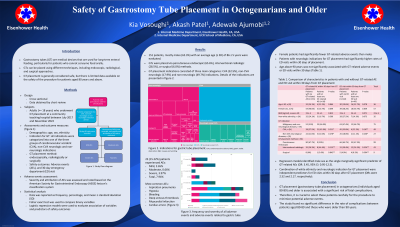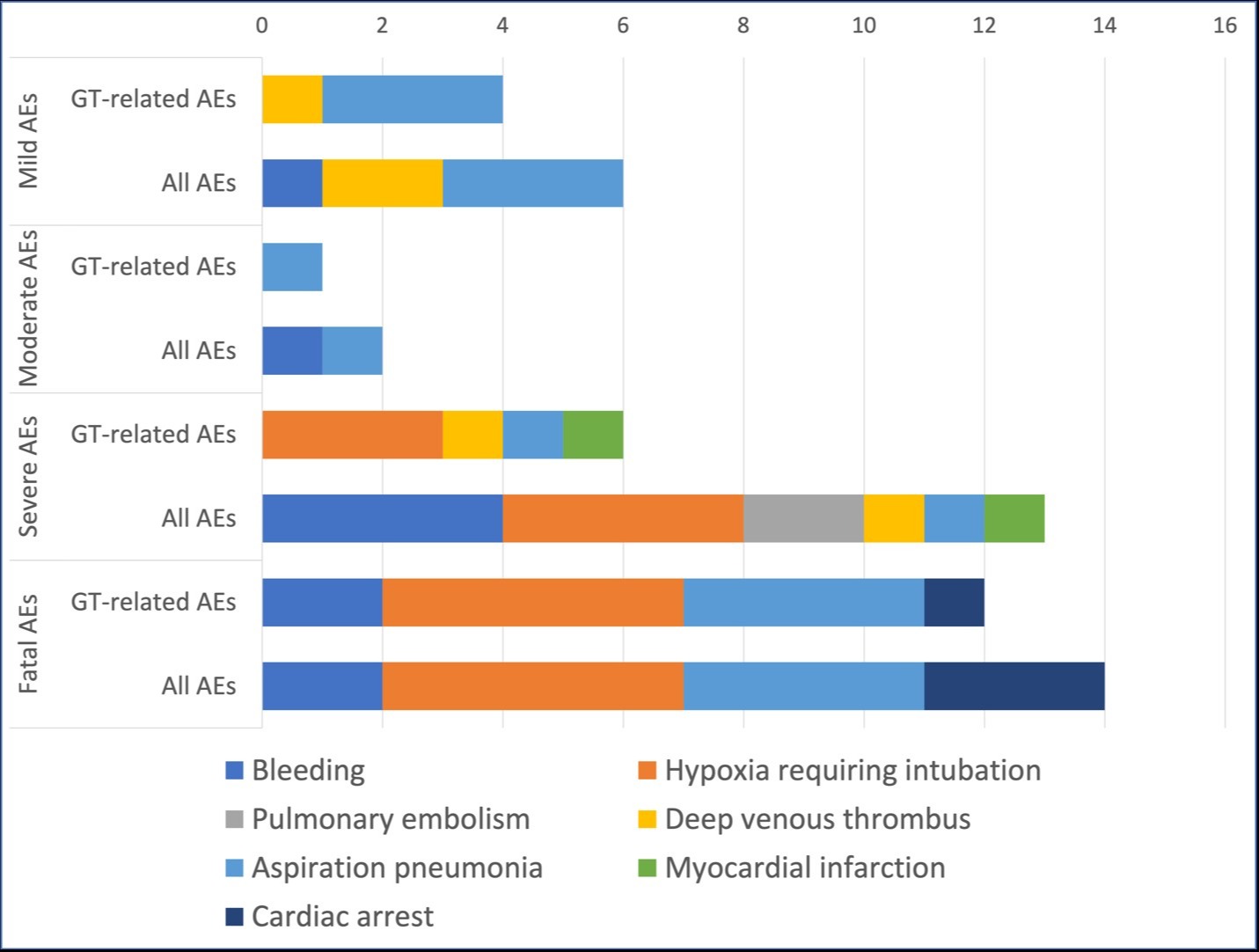Monday Poster Session
Category: General Endoscopy
P1971 - Safety of Gastrostomy Tube Placement in Octogenarians and Older
Monday, October 23, 2023
10:30 AM - 4:15 PM PT
Location: Exhibit Hall

Has Audio

Kia Vosoughi, MD, MPH
Eisenhower Health
Rancho Mirage, California
Presenting Author(s)
Kia Vosoughi, MD, MPH1, Akash Patel, MD1, Adewale Ajumobi, MD, MBA, FACG2
1Eisenhower Health, Rancho Mirage, CA; 2Eisenhower Health, University of California, Rancho Mirage, CA
Introduction: Gastrostomy tube (GT) is a widely used device for long-term enteral feeding. GT can be placed endoscopically, radiologically or surgically. They are generally considered safe; however, there is limited data available on the safety outcome of GT placement for patients aged 80 years and above.
Methods: Adults who underwent GT placement at a community teaching hospital between July 2017 and November 2022 were retrospectively evaluated. Demographics, GT indication, procedure details, and outcomes were extracted from chart reviews. Patients were classified into three groups: cerebrovascular accident (CVA), non-CVA neurologic, and non-neurologic indications. Outcomes were assessed by the occurrence and severity of adverse events (AEs) and 30-day emergency department (ED) visits. The American Society for Gastrointestinal Endoscopy (ASGE) lexicon was used to identify AE severity and attribution.
Results: In this study, 151 patients (62.3% males) with an average age of 86 ± 5 years received a GT for long-term feeding through percutaneous endoscopic (65.6%), interventional radiologic (28.5%), or surgical (6.0%) placement. Of the total patients, 23 (15.22%) experienced adverse events related to GT placement, with varying severity levels (mild 2.65%, moderate 0.66%, severe 3.97%, fatal 7.94%). Aspiration pneumonia was the most common adverse event, followed by hypoxia requiring intubation, bleeding, deep venous thrombosis (DVT), myocardial infarction (MI), and cardiac arrest (figure 1). Female patients had fewer GT-related adverse events, while no significant association was found between age ≥90 years and GT-related adverse events or ED visits (table 1). Regression models identified the male sex as a marginally significant predictor of GT-related AEs (OR: 3.45, 95% CI: 0.95-12.5). A combination of white ethnicity and CVA indication for GT placement were identified as independent predictors for ED visits within 30 days after GT placement- the ORs were 2.52 (95% CI: 0.99-6.39) for white ethnicity and 2.17(95% CI: 1.04-4.51) for CVA indication.
Discussion: GT placement in octogenarians and older was associated with a considerable number of complications. Therefore, these patients should be selected carefully for this procedure. There was no difference in the complication rates between patients aged 80-89 and those that were older.

Disclosures:
Kia Vosoughi, MD, MPH1, Akash Patel, MD1, Adewale Ajumobi, MD, MBA, FACG2. P1971 - Safety of Gastrostomy Tube Placement in Octogenarians and Older, ACG 2023 Annual Scientific Meeting Abstracts. Vancouver, BC, Canada: American College of Gastroenterology.
1Eisenhower Health, Rancho Mirage, CA; 2Eisenhower Health, University of California, Rancho Mirage, CA
Introduction: Gastrostomy tube (GT) is a widely used device for long-term enteral feeding. GT can be placed endoscopically, radiologically or surgically. They are generally considered safe; however, there is limited data available on the safety outcome of GT placement for patients aged 80 years and above.
Methods: Adults who underwent GT placement at a community teaching hospital between July 2017 and November 2022 were retrospectively evaluated. Demographics, GT indication, procedure details, and outcomes were extracted from chart reviews. Patients were classified into three groups: cerebrovascular accident (CVA), non-CVA neurologic, and non-neurologic indications. Outcomes were assessed by the occurrence and severity of adverse events (AEs) and 30-day emergency department (ED) visits. The American Society for Gastrointestinal Endoscopy (ASGE) lexicon was used to identify AE severity and attribution.
Results: In this study, 151 patients (62.3% males) with an average age of 86 ± 5 years received a GT for long-term feeding through percutaneous endoscopic (65.6%), interventional radiologic (28.5%), or surgical (6.0%) placement. Of the total patients, 23 (15.22%) experienced adverse events related to GT placement, with varying severity levels (mild 2.65%, moderate 0.66%, severe 3.97%, fatal 7.94%). Aspiration pneumonia was the most common adverse event, followed by hypoxia requiring intubation, bleeding, deep venous thrombosis (DVT), myocardial infarction (MI), and cardiac arrest (figure 1). Female patients had fewer GT-related adverse events, while no significant association was found between age ≥90 years and GT-related adverse events or ED visits (table 1). Regression models identified the male sex as a marginally significant predictor of GT-related AEs (OR: 3.45, 95% CI: 0.95-12.5). A combination of white ethnicity and CVA indication for GT placement were identified as independent predictors for ED visits within 30 days after GT placement- the ORs were 2.52 (95% CI: 0.99-6.39) for white ethnicity and 2.17(95% CI: 1.04-4.51) for CVA indication.
Discussion: GT placement in octogenarians and older was associated with a considerable number of complications. Therefore, these patients should be selected carefully for this procedure. There was no difference in the complication rates between patients aged 80-89 and those that were older.

Figure: Figure 1. Frequency and severity of all adverse events and adverse events related to gastric tube. AE, adverse event; GT, gastric tube.
Disclosures:
Kia Vosoughi indicated no relevant financial relationships.
Akash Patel indicated no relevant financial relationships.
Adewale Ajumobi indicated no relevant financial relationships.
Kia Vosoughi, MD, MPH1, Akash Patel, MD1, Adewale Ajumobi, MD, MBA, FACG2. P1971 - Safety of Gastrostomy Tube Placement in Octogenarians and Older, ACG 2023 Annual Scientific Meeting Abstracts. Vancouver, BC, Canada: American College of Gastroenterology.
